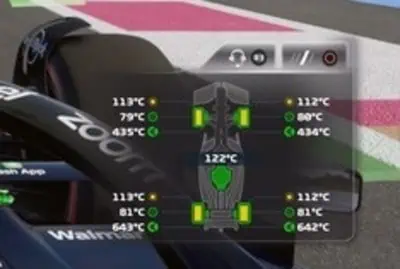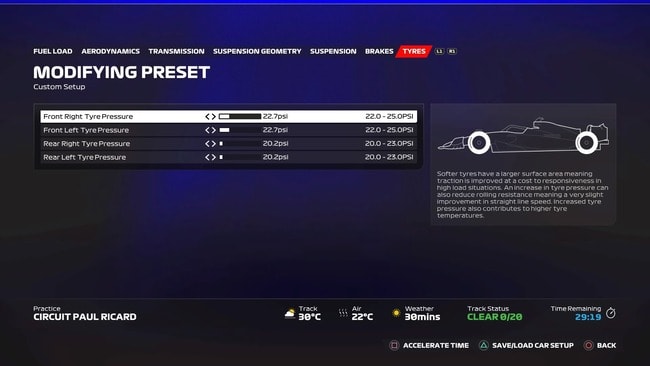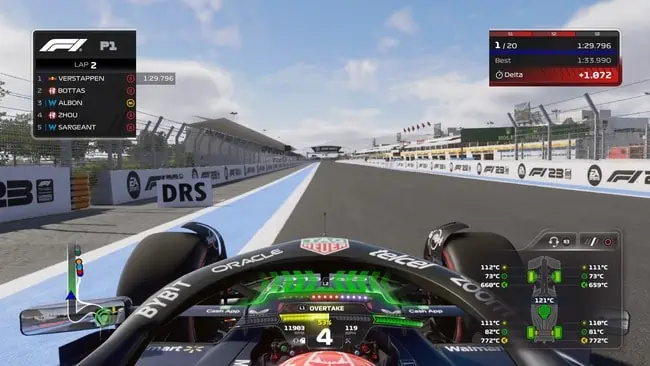The tyres being sensitive to overheating has been a feature of the last few F1 games now, and it’s been carried over into the latest F1 23 edition as well.
If you use the wrong driving style or setup on the wrong track (especially the wrong tyre pressures), then your tyres will be overheating and your pace will suffer (understeer, lack of grip and traction).
In this guide, we’ll show you why and at what level this happens, and how to stop it happening. Let’s get started.
When & Why The Tyres Overheat
Simulating what happens in real life, if the tyres are put under too much pressure, especially during repeated, prolonged/high speed corners, they will start to overheat and performance will suffer. Moreover, as in real life, overheating tyres is a cumulative problem, in that once it’s really gone past a certain level, it’s very hard to bring the temps back to normal, and the problem just gets worse until you change tyres.
Check the tyres menu on the Multi-Function Display (MFD) in the bottom right corner:

Pay special attention to the small dot at the top of each tyre – that’s the main one that fluctuates, and once the temperatures goes over 106/107 degrees Celsius, you’ve got a problem and they start turning yellow.
Then, once the 4 tyres on the actual car in the middle start turning yellow, you know you’re in real trouble and are unlikely to get the temps back under control.
The main reasons that tyres overheat are:
- Running too high pressures (the biggest factor by far – see further below)
- Racing on tracks with lots of high speed, prolonged corners, especially one after another in the same direction.
- Being too aggressive on the throttle out of corners (hurts the rear tyres)
- Not being smooth with steering (hurts front tyres)
- “Leaning” on the tyres a lot out of prolonged corner exits (using full throttle early and stressing the tyre all the way through corner exit).
Some tracks that are especially bad for overheating tyres are:
- Bahrain
- Spain
- Monaco
- France
- Hungary
- Singapore
- Qatar
- Texas
- Abu Dhabi
The above temperature map was taken when I did an experiment on running maximum tyre pressures at France, and it basically took just 1 lap for the tyres to start overheating.
What Happens When Tyres Overheat?
When tyres overheat on the F1 23 game, then as in real life, lap times start to suffer.
If the front tyres overheat, you start to get understeer, where the car doesn’t turn as much as you want to in corners.
If the rear tyres overheat, then traction starts to suffer, and you may spin out altogether in prolonged corners as the tyres “give up” and lose all grip if they’ve gone beyond a certain temperature.
How To Prevent Tyres Overheating In F1 23
By far the biggest factor in preventing tyres overheating is to set the correct tyre pressures – not too high. You can tweak pressures from the car setup menu under Tyres:

Basically, on F1 23, you need to always run tyres pressures between the middle and minimum values, but never above the middle, the prevent overheating (see below for track by track recommended settings).
You need to run tyre pressures so that your tyres never go above 106/107 Degrees Celsius on every track
And as far as the optimum or ideal tyre temperature range where they work at their best in terms of grip, that varies by tyre:
- Soft tyre (red) – 100-105 Degrees Celsius
- Medium (yellow)/Hard (white) – 95-100 Degrees Celsius
And basically, never let any tyre go above 105 Degrees, though it’s the most problematic with the red soft tyre. Once they do go above this point, it’s hard to bring them back down to the ideal window, and performance is likely to get worse and worse, especially on tracks with lots of corners one after the other in one direction.
And then some driving style tips to prevent overheating:
- Try to be as smooth as possible both on steering and traction to not overly stress the tyres. Gradually ease on the throttle out of corner exits, and try to keep steering smooth and consistent rather than jerky and aggressive.
- Lift off the throttle in long, high speed corners, especially when the tyres are worn or reaching the edge of the operating window
- Use only Medium and Hard tyres for longer races and stay away mostly from the soft tyre.
Optimal Tyre Pressures For All Tracks
Now let’s give some optimal tyre pressure settings for all tracks. These settings should prevent tyres overheating as long as you drive reasonably smoothly.
- Bahrain – Minimum pressures all tyres
- Saudi Arabia – Fronts 22.7; Rears 20.3
- Australia – Fronts 22.6; Rears 20.1
- Baku – Fronts 23.0; Rears 20.2
- Imola – Fronts 22.7; Rears 20.3
- Miami – Fronts 22.9; Rears 20.4
- Monaco – Minimum pressures all tyres
- Spain – Fronts 22.4; Rears 20.2
- Canada – Fronts 22.6; Rears 20.2
- Austria – Fronts 22.9; Rears 20.3
- Great Britain – Fronts 22.7; Rears 20.3
- Hungary – Fronts 22.5; Rears Minimum
- Spa – Fronts 23.6; Rears 20.8
- Zandvoort – Fronts 22.7; Rears 20.1
- Monza – Fronts 24.1; Rears 21.4
- Singapore – Fronts 22.2; Rears minimum
- Japan – Fronts 23.3; Rears 20.5
- Qatar – Minimum pressures all tyres
- USA Texas – Fronts 22.2; Rears 20.2
- Mexico – Fronts 22.7; Rears 20.3
- Brazil – Fronts 22.7; Rears 20.2
- Las Vegas – Fronts 24.1; Rears 21.2
- Abu Dhabi – Fronts 22.7; Rears 20.2
- China – Fronts 22.5; Rears 20.1
- Portugal – Fronts 22.4; Rears 20.1
- France – Minimum pressures all tyres
The this channel is also an excellent resource for car setups in general, including optimal tyre pressures to run.

